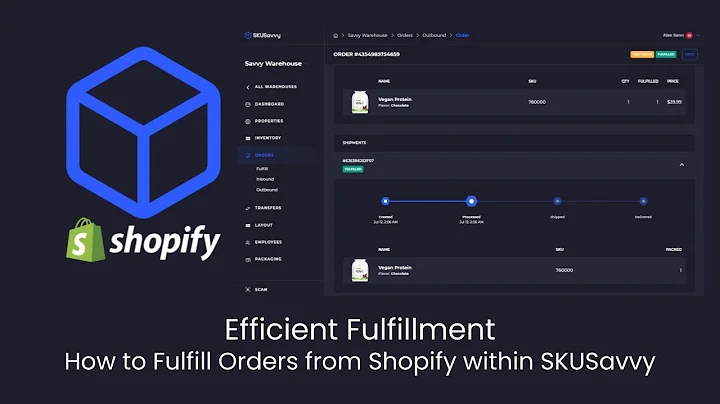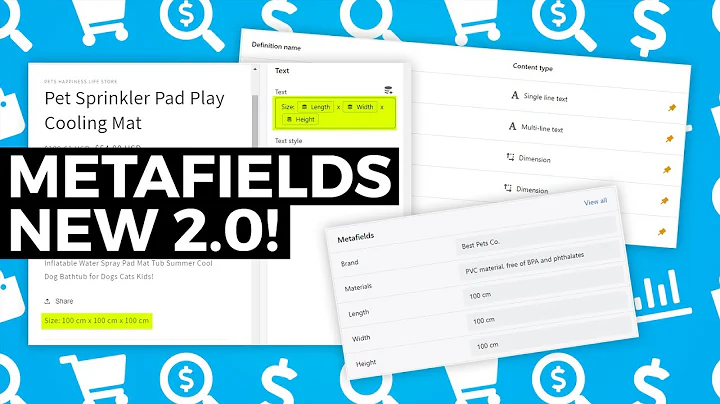Supercharge Your eCommerce Sales with HubSpot & Shopify
Table of Contents
- Introduction
- Background and Experience at HubSpot
- The Lucrative E-commerce Market
- HubSpot's Tools for E-commerce Marketing
- 4.1 CRM (Customer Relationship Management)
- 4.2 Email Marketing
- 4.3 Workflows and Automation
- 4.4 Reporting and Analytics
- 4.5 Integration Options
- 4.6 Live Chat and Conversations Inbox
- 4.7 Ads Integration
- Using HubSpot for E-commerce Marketing
- 5.1 Email Creation and Personalization
- 5.2 Email Reporting and Analysis
- 5.3 Workflows for Automated Marketing
- 5.4 Integration with Live Chat and Conversations Inbox
- 5.5 Ads Integration and Reporting
- Conclusion
Boosting E-commerce Sales with HubSpot: How to Leverage the Power of Marketing Automation and Personalization
Introduction
In today's digital age, the e-commerce market is thriving, with trillions of dollars in sales expected worldwide. As an e-commerce business owner, it's crucial to leverage marketing tools and strategies to boost your sales and stay ahead of the competition. One such tool is HubSpot, a comprehensive platform that offers a range of features designed specifically for e-commerce marketing.
In this article, we will explore how HubSpot can help you enhance your e-commerce sales. We'll delve into the various tools and functionalities it offers, such as customer relationship management (CRM), email marketing, workflows and automation, reporting and analytics, live chat and conversations inbox, and integration options with popular e-commerce platforms.
But before we dive into the details, let's first understand the background and experience of HubSpot as a company.
Background and Experience at HubSpot
HubSpot is a leading provider of inbound marketing, sales, and customer service software. With its headquarters in Dublin, Ireland, HubSpot offers a range of tools and solutions designed to help businesses attract, engage, and delight their customers.
As a solutions engineer at HubSpot, I have worked closely with e-commerce businesses for nearly four years. With a background in web development and a passion for e-commerce, I have witnessed the transformative power of HubSpot's tools firsthand. In this article, I aim to share my knowledge and expertise to help you navigate the e-commerce landscape using HubSpot as your marketing ally.
The Lucrative E-commerce Market
The e-commerce market is booming, with trillions of dollars in sales projected worldwide. With the advent of digital transformation, consumers are increasingly turning to online shopping, making it vital for businesses to establish a strong online presence and leverage effective marketing strategies.
According to industry reports, e-commerce sales are expected to reach $4.2 trillion by the end of 2020 globally. By 2023, this figure is projected to grow to $6.5 trillion. Moreover, it is estimated that 2.1 billion people will make online purchases in 2021. In Ireland alone, e-commerce sales are predicted to reach $3.3 million by the end of 2020, with a growth rate of 8.6% year on year. The adoption rate of online purchasing in Ireland is expected to reach 77.5% by the end of 2024, showcasing a tremendous opportunity for businesses operating in this market.
HubSpot's Tools for E-commerce Marketing
- CRM (Customer Relationship Management)
At the core of HubSpot's e-commerce tools lies its CRM, offering a 360-degree overview of customer data. The CRM tracks customer activity, including page views, email interactions, and form submissions, providing a single source of truth for all customer information. It also allows businesses to manage deals and track revenue associated with them. With the CRM, you have a comprehensive understanding of your customers and their purchasing patterns, enabling you to personalize your marketing efforts effectively.
Pros:
- Centralizes customer data for easy access and analysis.
- Tracks customer activity and interactions.
- Helps manage deals and revenue.
Cons:
- Requires proper utilization to derive maximum benefits.
- Email Marketing
Email marketing is a crucial component of any e-commerce strategy. HubSpot's email marketing tool allows businesses to send personalized emails to specific lists of contacts. Leveraging customer data from the CRM, you can tailor emails to individual recipients, including their name, past purchases, or current interests. HubSpot also offers automation options, allowing you to set rules triggering email sends based on specific criteria. For example, you can automate abandoned cart emails or create personalized recommendations based on customers' past purchases.
Pros:
- Enables personalized and automated email campaigns.
- Integrates with CRM data for maximum personalization.
- Offers A/B testing and advanced features like smart content.
Cons:
- Requires ongoing optimization to achieve desired results.
- Workflows and Automation
HubSpot's workflows tool provides the ability to automate and create sophisticated marketing campaigns. You can enroll contacts based on specific criteria, such as form submissions or deal closing dates, and set up sequences of actions triggered by these enrollments. Workflows allow you to nurture leads, re-engage with existing customers, and offer personalized experiences based on customer behavior. For example, you can send a series of follow-up emails to customers who recently made a purchase or create workflows for replenishment reminders based on product lifespan.
Pros:
- Automates marketing processes and saves time.
- Enables personalized customer journeys based on behavior.
- Helps nurture leads and re-engage with customers.
Cons:
- Requires careful planning and monitoring to avoid over-automation.
- Reporting and Analytics
HubSpot offers a range of reporting and analytics features to evaluate the success of your e-commerce marketing efforts. You can access pre-built e-commerce dashboards that provide insights into customer lifetime value, revenue attribution, average deal sizes, and more. These dashboards help you identify trends, understand the impact of different marketing channels, and make data-driven decisions. HubSpot also allows you to create custom reports, enabling you to analyze specific metrics or measure the success of targeted campaigns.
Pros:
- Provides pre-built e-commerce dashboards for instant insights.
- Offers multi-touch revenue attribution for accurate tracking.
- Enables customized reports for granular analysis.
Cons:
- Requires interpretation and continuous optimization.
- Integration Options
HubSpot provides seamless integration options with popular e-commerce platforms, including Shopify, WooCommerce, Magento, and BigCommerce, among others. These integrations allow you to sync your e-commerce store with HubSpot, enabling the flow of data between the two platforms. For example, with the native Shopify integration, you can sync your product catalog, customer information, and order details. HubSpot also offers integration with advertising platforms like Google Ads and Facebook Ads, allowing you to streamline your paid advertising efforts.
Pros:
- Enables data synchronization between e-commerce platforms and HubSpot.
- Offers seamless integration with popular e-commerce platforms.
- Facilitates comprehensive marketing automation across platforms.
Cons:
- May require additional setup or development resources for custom integrations.
- Live Chat and Conversations Inbox
HubSpot's live chat function allows businesses to provide immediate assistance to website visitors. You can add a live chat widget to your online store and engage in real-time conversations with customers. The conversations inbox centralizes all customer communication, including live chat, email, forms, and more, in one easy-to-use interface. This functionality enables personalized interactions, helps answer customer inquiries, and facilitates improved customer support.
Pros:
- Provides real-time communication with website visitors.
- Centralizes customer conversations in one inbox.
- Helps improve customer support and satisfaction.
Cons:
- Requires dedicated resources for timely response and management.
- Ads Integration
HubSpot allows businesses to connect their ads accounts, such as LinkedIn, Facebook, and Google Ads, to the CRM. This integration enables the tracking of ad clicks and conversions in HubSpot, providing valuable insights into the performance of your ad campaigns. You can analyze data on customer acquisition, cost per click, and return on investment, helping you optimize your ad spend and target the right audience. Additionally, HubSpot allows you to sync contact data with ad platforms for retargeting or lookalike audience creation.
Pros:
- Tracks ad performance and ROI in one centralized platform.
- Enables retargeting and lookalike audience creation.
- Provides insights to optimize ad campaigns.
Cons:
- May require initial setup and ongoing monitoring.
Using HubSpot's suite of e-commerce marketing tools, businesses have the opportunity to maximize their sales and engage customers effectively. By leveraging personalized email marketing, automation workflows, and advanced reporting features, you can drive revenue and create a seamless shopping experience for your customers. With the ability to integrate with popular e-commerce platforms and provide exceptional customer support through live chat, HubSpot offers the necessary tools to succeed in the competitive e-commerce landscape.
In conclusion, HubSpot's e-commerce tools provide businesses with powerful capabilities to boost their sales and enhance their online presence. By leveraging the tools and strategies outlined in this article, e-commerce businesses can stay ahead of the competition and create personalized experiences that drive customer loyalty and revenue growth. So, take advantage of HubSpot's e-commerce features and unlock the full potential of your online store.
Highlights
- HubSpot offers a comprehensive suite of e-commerce marketing tools.
- The CRM centralizes customer data and manages deals and revenue.
- Email marketing enables personalized and automated campaigns.
- Workflows automate marketing processes and nurture leads.
- Reporting and analytics provide insights for data-driven decisions.
- Integration options include popular e-commerce platforms.
- Live chat improves customer support and satisfaction.
- Ads integration tracks ad performance and improves targeting.
- HubSpot offers a range of resources and documentation for seamless implementation.
- Leveraging HubSpot's tools can drive revenue and enhance the shopping experience.
FAQ
Q: Can HubSpot integrate with other e-commerce platforms besides Shopify?
A: Yes, HubSpot offers native integrations with various e-commerce platforms, including WooCommerce, Magento, and BigCommerce, among others.
Q: Are the e-commerce tools in HubSpot suitable for both small and large businesses?
A: Yes, HubSpot's e-commerce tools cater to businesses of all sizes. Whether you're a small online store or a large enterprise, you can leverage HubSpot's features to enhance your e-commerce marketing efforts.
Q: Can I create custom email templates in HubSpot?
A: Yes, HubSpot provides the flexibility to create custom email templates. You can build emails from scratch using your own HTML and CSS or modify existing templates to align with your brand's visual identity.
Q: Does HubSpot offer A/B testing for email campaigns?
A: Yes, HubSpot's email marketing tool allows for A/B testing, enabling you to experiment with different subject lines, email content, and design elements to optimize email performance and engagement.
Q: How can HubSpot help with abandoned cart recovery?
A: HubSpot's workflows tool enables businesses to create automated workflows triggered by abandoned carts. These workflows can send personalized emails to customers reminding them of their abandoned carts and offering incentives to complete their purchases.
Q: Can HubSpot track the success of advertising campaigns?
A: Yes, HubSpot's ads integration allows businesses to track the performance of their ad campaigns directly within the platform. By syncing ad accounts and campaigns, you can monitor key metrics, such as click-through rates and return on ad spend (ROAS).
Remember, using HubSpot's e-commerce tools requires proactive use and continual optimization to achieve the desired results. With dedication and a customer-focused approach, you can leverage HubSpot's resources to enhance your e-commerce marketing efforts and drive business growth.






















